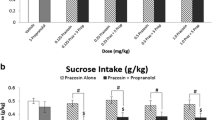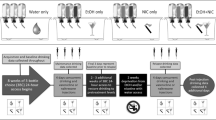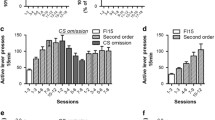Abstract
Rationale
Two pharmacotherapies are approved for treating alcohol craving (acamprosate and naltrexone), but both have shown mixed findings in animals and humans.
Objectives
The present experiments utilized a “reinforcer blocking” approach (i.e., rats were able to consume ethanol during treatment) to better understand the efficacy of these treatments for ethanol seeking and drinking using ethanol-dependent and nondependent rats.
Materials and methods
In “nondependent” experiments, drugs (acamprosate 50, 100, and 200 mg/kg; naltrexone 0.1, 0.3, and 1.0 mg/kg) were administered over 3-week periods prior to operant sessions with a low response requirement to gain access to reinforcers for 20 min. For “dependent” experiments, rats were made dependent in vapor/inhalation chambers.
Results
Acamprosate and naltrexone had similar effects on intake in nondependent and dependent rats; neither drug was selective for ethanol over sucrose drinking. In nondependent animals, naltrexone was more efficacious at more doses than acamprosate, and acamprosate’s effects were limited to a dose that also had adverse effects on body weight. Both pharmacotherapies showed more selectivity when examining reinforcer seeking. In nondependent rats, acamprosate and naltrexone had response-attenuating effects in ethanol, but not sucrose, groups. In dependent animals, acamprosate had selective effects limited to a decrease in sucrose seeking. Naltrexone, however, selectively decreased ethanol-seeking in nondependent rats.
Conclusions
The naltrexone-induced decreases in seeking suggested a change in incentive motivation which was selective for ethanol in nondependent rats. The “nondependent” paradigm may model early stages of “problem drinking” in humans, and the findings suggest that naltrexone could be a good intervention for this level of alcohol abuse and relapse prevention.






Similar content being viewed by others
References
Anton RF, O'Malley SS, Ciraulo DA, Cisler RA, Couper D, Donovan DM, Gastfriend DR, Hosking JD, Johnson BA, LoCastro JS, Longabaugh R, Mason BJ, Mattson ME, Miller WR, Pettinati HM, Randall CL, Swift R, Weiss RD, Williams LD, Zweben A, COMBINE Study Research Group (2006) Combined pharmacotherapies and behavioral interventions for alcohol dependence: the COMBINE Study: a randomized controlled trial. JAMA 295:2003–2017
Anton RF, Oroszi G, O'Malley S, Couper D, Swift R, Pettinati H, Goldman D (2008) An evaluation of mu-opioid receptor (OPRM1) as a predictor of naltrexone response in the treatment of alcohol dependence: results from the Combined Pharmacotherapies and Behavioral Interventions for Alcohol Dependence (COMBINE) Study. Arch Gen Psychiatry 65:135–144
Bachteler D, Economidou D, Danysz W, Ciccocioppo R, Spanagel R (2005) The effects of acamprosate and neramexane on cue-induced reinstatement of ethanol-seeking behavior in rat. Neuropsychopharmacology 30:1104–1110
Baros AM, Latham PK, Moak DH, Voronin K, Anton RF (2007) What role does measuring medication compliance play in evaluating the efficacy of naltrexone? Alcohol Clin Exp Res 31:596–603
Boismare F, Daoust M, Moore N, Saligaut C, Lhuintre JP, Chretien P, Durlach J (1984) A homotaurine derivative reduces the voluntary intake of ethanol by rats: are cerebral GABA receptors involved? Pharmacol Biochem Behav 21:787–789
Bouza C, Angeles M, Muñoz A, Amate JM (2004) Efficacy and safety of naltrexone and acamprosate in the treatment of alcohol dependence: a systematic review. Addiction 99:811–828
Bowers MS, Chen BT, Chou JK, Osborne MP, Gass JT, See RE, Bonci A, Janak PH, Olive MF (2007) Acamprosate attenuates cocaine- and cue-induced reinstatement of cocaine-seeking behavior in rats. Psychopharmacology 195:397–406
Chick J, Howlett H, Morgan MY, Ritson B (2000) United Kingdom multicentre acamprosate study (UKMAS): a 6-month prospective study of acamprosate versus placebo in preventing relapse after withdrawal from alcohol. Alcohol Alcohol 35:176–187
Ciccocioppo R, Lin D, Martin-Fardon R, Weiss F (2003) Reinstatement of ethanol-seeking behavior by drug cues following single versus multiple ethanol intoxication in the rat: effects of naltrexone. Psychopharmacology 168:208–215
Cowen MS, Adams C, Kraehenbuehl T, Vengeliene V, Lawrence AJ (2005) The acute anti-craving effect of acamprosate in alcohol-preferring rats is associated with modulation of the mesolimbic dopamine system. Addict Biol 10:233–242
Czachowski CL, Samson HH (1999) Breakpoint determination and ethanol self-administration using a discrete session progressive ratio procedure in the rat. Alcohol Clin Exp Res 23:1580–1586
Czachowski CL, Chappell AM, Samson HH (2001a) The effects of raclopride in the nucleus accumbens on ethanol-seeking and consumption. Alcohol Clin Exp Res 25:1431–1440
Czachowski CL, Legg BH, Samson HH (2001b) The effects of acamprosate on ethanol-seeking and self-administration in the rat. Alcohol Clin Exp Res 25:344–350
Czachowski CL, Santini LA, Legg BH, Samson HH (2002) Separate measures of ethanol seeking and drinking in the rat: effects of remoxipride. Alcohol 28:39–46
Donovan DM, Anton RF, Miller WR, Longabaugh R, Hosking JD, Youngblood M, COMBINE Study Research Group (2008) Combined pharmacotherapies and behavioral interventions for alcohol dependence (The COMBINE Study): examination of posttreatment drinking outcomes. J Stud Alcohol Drugs 69:5–13
Ferraro FM 3rd, Hill KG, Kaczmarek HJ, Coonfield DL, Kiefer SW (2002) Naltrexone modifies the palatability of basic tastes and alcohol in outbred male rats. Alcohol 27:107–114
Funk CK, Koob GF (2007) A CRF(2) agonist administered into the central nucleus of the amygdala decreases ethanol self-administration in ethanol-dependent rats. Brain Res 1155:172–178
Gonzales RA, Weiss F (1998) Suppression of ethanol-reinforced behavior by naltrexone is associated with attenuation of the ethanol-induced increase in dialysate dopamine levels in the nucleus accumbens. J Neurosci 18:10663–10671
Heilig M, Egli M (2006) Pharmacological treatment of alcohol dependence: target symptoms and target mechanisms. Pharmacol Ther 111:855–876
Heinälä P, Alho H, Kiianmaa K, Lönnqvist J, Kuoppasalmi K, Sinclair JD (2001) Targeted use of naltrexone without prior detoxification in the treatment of alcohol dependence: a factorial double-blind, placebo-controlled trial. J Clin Psychopharmacol 21:287–292
Heyser CJ, Schulteis G, Durbin P, Koob GF (1998) Chronic acamprosate eliminates the alcohol deprivation effect while having limited effects on baseline responding for ethanol in rats. Neuropsychopharmacology 18:125–133
Heyser CJ, Moc K, Koob GF (2003) Effects of naltrexone alone and in combination with acamprosate on the alcohol deprivation effect in rats. Neuropsychopharmacology 28:1463–1471
Hodge CW, Cox AA, Bratt AM, Camarini R, Iller K, Kelley SP, Mehmert KK, Nannini MA, Olive MF (2001) The discriminative stimulus properties of self-administered ethanol are mediated by GABA(A) and NMDA receptors in rats. Psychopharmacology 154:13–22
Hölter SM, Landgraf R, Zieglgänsberger W, Spanagel R (1997) Time course of acamprosate action on operant ethanol self-administration after ethanol deprivation. Alcohol Clin Exp Res 21:862–868
Ji D, Gilpin NW, Richardson HN, Rivier CL, Koob GF (2008) Effects of naltrexone, duloxetine, and a corticotropin-releasing factor type 1 receptor antagonist on binge-like alcohol drinking in rats. Behav Pharmacol 19:1–12
Johnson BA (2008) Update on neuropharmacological treatments for alcoholism: scientific basis and clinical findings. Biochem Pharmacol 75:34–56
Killeen TK, Brady KT, Gold PB, Simpson KN, Faldowski RA, Tyson C, Anton RF (2004) Effectiveness of naltrexone in a community treatment program. Alcohol Clin Exp Res 28:1710–1717
Lee YK, Park SW, Kim YK, Kim DJ, Jeong J, Myrick H, Kim YH (2005) Effects of naltrexone on the ethanol-induced changes in the rat central dopaminergic system. Alcohol Alcohol 40:297–301
LeMagnen J, Tran G, Durlach J, Martin C (1987) Dose-dependent suppression of the high alcohol intake of chronically intoxicated rats by Ca-acetyl homotaurinate. Alcohol 4:97–102
Littleton JM (1995) Acamprosate in alcohol dependence: how does it work. Addiction 90:1179–1188
Macenski MJ, Shelton KL (2001) Self-administered ethanol as a discriminative stimulus in rats. Drug Alcohol Depend 64:243–247
McGeary JE, Monti PM, Rohsenow DJ, Tidey J, Swift R, Miranda R Jr. (2006) Genetic moderators of naltrexone’s effects on alcohol cue reactivity. Alcohol Clin Exp Res 30:1288–1296
Morley KC, Teesson M, Reid SC, Sannibale C, Thomson C, Phung N, Weltman M, Bell JR, Richardson K, Haber PS (2006) Naltrexone versus acamprosate in the treatment of alcohol dependence: a multi-centre, randomized, double-blind, placebo-controlled trial. Addiction 101:1451–1462
Naassila M, Legrand E, d’Alche-Biree F, Daoust M (1998) Cyamemazine decreases ethanol intake in rats and convulsions during ethanol withdrawal syndrome in mice. Psychopharmacology 140:421–428
Nava F, Premi S, Manzato E, Lucchini A (2006) Comparing treatments of alcoholism on craving and biochemical measures of alcohol consumption. J Psychoactive Drugs 38:211–217
NIH (1996) NIH guide, vol 25, number 28. National Academy Press, Washington, DC
O’Dell LE, Roberts AJ, Smith RT, Koob GF (2004) Enhanced alcohol self-administration after intermittent versus continuous alcohol vapor exposure. Alcohol Clin Exp Res 28:1676–1682
O’Malley SS, Jaffe AJ, Chang G, Schottenfeld RS, Meyer RE, Rounsaville B (1992) Naltrexone and coping skills therapy for alcohol dependence. A controlled study. Arch Gen Psychiatry 49:881–887
O’Malley SS, Robin RW, Levenson AL, GreyWolf I, Chance LE, Hodgkinson CA, Romano D, Robinson J, Meandzija B, Stillner V, Wu R, Goldman D (2008) Naltrexone alone and with sertraline for the treatment of alcohol dependence in Alaska natives and non-natives residing in rural settings: a randomized controlled trial. Alcohol Clin Exp Res 32:1271–1283
Paille F, Guelfi JD, Perkins AC, Royer RJ, Steru L, Parot P (1995) Double-blind randomized multicentre trial of acamprosate in maintaining abstinence from alcohol. Alcohol Alcohol 30:239–247
Ray LA, Hutchison KE (2007) Effects of naltrexone on alcohol sensitivity and genetic moderators of medication response: a double-blind placebo-controlled study. Arch Gen Psychiatry 64:1069–1077
Richardson K, Baillie A, Reid S, Morley K, Teesson M, Sannibale C, Weltman M, Haber P (2008) Do acamprosate or naltrexone have an effect on daily drinking by reducing craving for alcohol? Addiction 103:953–959
Roberts AJ, Cole M, Koob GF (1996) Intra-amygdala muscimol decreases operant ethanol self-administration in dependent rats. Alcohol Clin Exp Res 20:1289–1298
Sabino V, Cottone P, Koob GF, Steardo L, Lee MJ, Rice KC, Zorrilla EP (2006) Dissociation between opioid and CRF1 antagonist sensitive drinking in Sardinian alcohol-preferring rats. Psychopharmacology 189:175–186
Samson HH (1986) Initiation of ethanol reinforcement using a sucrose-substitution procedure in food- and water-sated rats. Alcohol Clin Exp Res 10:436–442
Samson HH, Czachowski CL, Slawecki CJ (2000) A new assessment of the ability of oral ethanol to function as a reinforcing stimulus. Alcohol Clin Exp Res 24:766–773
Samson HH, Chappell A, Czachowski C, Sharpe A (2001) Measuring ethanol-seeking behavior: the effect of using repeated extinction trials. Alcohol 24:205–209
Samson HH, Cunningham CL, Czachowski CL, Chappell A, Legg B, Shannon E (2004) Devaluation of ethanol reinforcement. Alcohol 32:203–212
Sharpe AL, Samson HH (2001) Effect of naloxone on appetitive and consummatory phases of ethanol self-administration. Alcohol Clin Exp Res 25:1006–1011
Spanagel R, Zieglgansberger W (1997) Anti-craving compounds for ethanol: new pharmacological tools to study addictive processes. Trends Pharmacol Sci 18:54–59
Stromberg MF (2004) The effect of baclofen alone and in combination with naltrexone on ethanol consumption in the rat. Pharmacol Biochem Behav 78:743–750
Stromberg MF, Volpicelli JR, O’Brien CP (1998) Effects of naltrexone administered repeatedly across 30 or 60 days on ethanol consumption using a limited access procedure in the rat. Alcohol Clin Exp Res 22:2186–2191
Stromberg MF, Mackler SA, Volpicelli JR, O’Brien CP (2001) Effect of acamprosate and naltrexone, alone or in combination, on ethanol consumption. Alcohol 23:109–116
Stromberg MF, Sengpiel T, Mackler SA, Volpicelli JR, O’Brien CP, Vogel WH (2002a) Effect of naltrexone on oral consumption of concurrently available ethanol and cocaine in the rat. Alcohol 28:169–179
Stromberg MF, Rukstalis MR, Mackler SA, Volpicelli JR, O’Brien CP (2002b) A comparison of the effects of 6-beta naltrexol and naltrexone on the consumption of ethanol or sucrose using a limited-access procedure in rats. Pharmacol Biochem Behav 72:483–490
Tempesta E, Janiri L, Bignamini A, Chabac S, Potgieter A (2000) Acamprosate and relapse prevention in the treatment of alcohol dependence: a placebo-controlled study. Alcohol Alcohol 35:202–209
Ulm RR, Volpicelli JR, Volpicelli LA (1995) Opiates and alcohol self-administration in animals. J Clin Psychiatry 56(Supple 7):5–14
Volpicelli JR, Alterman AI, Hayashida M, O’Brien CP (1992) Naltrexone in the treatment of alcohol dependence. Arch Gen Psychiatry 49:876–880
Walker BM, Koob GF (2007) The gamma-aminobutyric acid-B receptor agonist baclofen attenuates responding for ethanol in ethanol-dependent rats. Alcohol Clin Exp Res 31:11–18
Walker BM, Koob GF (2008) Pharmacological evidence for a motivational role of kappa-opioid systems in ethanol dependence. Neuropsychopharmacology 33:643–652
Zhao Y, Weiss F, Zorrilla EP (2007) Remission and resurgence of anxiety-like behavior across protracted withdrawal stages in ethanol-dependent rats. Alcohol Clin Exp Res 31:1505–1515
Acknowledgments
This work was supported by grant AA013860 to CLC from the National Institute on Alcohol Abuse and Alcoholism. Acamprosate was generously provided by Forest Research Institute, Jersey City, NJ. Dr. Hank Samson provided insight and discussion essential for the development of the behavioral paradigm.
Author information
Authors and Affiliations
Corresponding author
Rights and permissions
About this article
Cite this article
Czachowski, C.L., DeLory, M.J. Acamprosate and naltrexone treatment effects on ethanol and sucrose seeking and intake in ethanol-dependent and nondependent rats. Psychopharmacology 204, 335–348 (2009). https://doi.org/10.1007/s00213-009-1465-z
Received:
Accepted:
Published:
Issue Date:
DOI: https://doi.org/10.1007/s00213-009-1465-z




